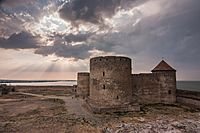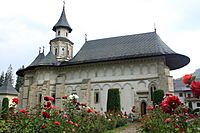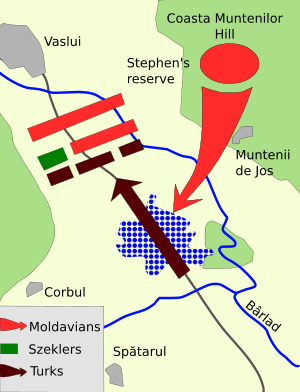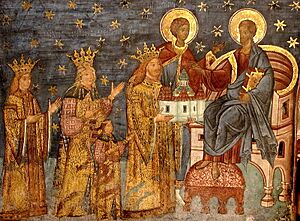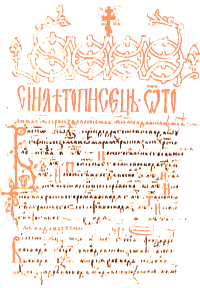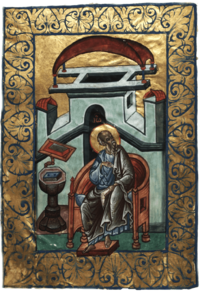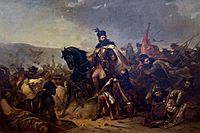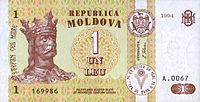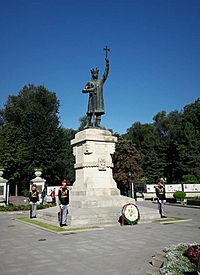Stephen the Great facts for kids
Quick facts for kids Stephen III the Great |
|
|---|---|
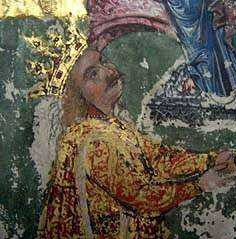
Miniature from the 1473 Gospel at Humor Monastery
|
|
| Prince of Moldavia | |
| Reign | 1457–1504 |
| Predecessor | Peter III Aaron |
| Successor | Bogdan III |
| Born | 1433–1440 Borzești |
| Died | 2 July 1504 (aged 64-71) Suceava |
| Burial | Putna Monastery |
| Spouse | Mărușca (?) Evdochia of Kiev Maria of Mangup Maria Voichița of Wallachia |
| Issue more... |
Alexandru Bogdan III Petru Rareș |
| Dynasty | Mușat |
| Father | Bogdan II of Moldavia |
| Mother | Maria Oltea |
| Religion | Orthodox Christian |
Stephen III of Moldavia, often called Stephen the Great, was a very important ruler (or Prince) of Moldavia from 1457 to 1504. He was the son of Bogdan II. After his father was killed by his uncle, Peter III Aaron, Stephen had to flee. He found help from Vlad III Țepeș, the ruler of Wallachia. With Vlad's support, Stephen returned to Moldavia and became prince in 1457.
Stephen fought against Poland to stop them from helping Peter Aaron. He later made peace with Poland in 1459. Stephen wanted to get back Chilia, an important port on the Danube. This led to conflicts with Hungary and Wallachia. He captured Chilia in 1464. In 1467, he defeated the Hungarian King Matthias Corvinus in the Battle of Baia. Stephen also improved Moldavia's defenses by restoring old fortresses and building new ones.
In 1473, Stephen stopped paying tribute to the Ottoman sultan. He then fought against Wallachia to replace its rulers, who were allied with the Ottomans. Stephen won a huge victory against a large Ottoman army in the Battle of Vaslui in 1475. Pope Sixtus IV called him "Champion of Christ." However, the Ottomans defeated Stephen the next year in the Battle of Valea Albă. They captured Chilia and Cetatea Albă (now Bilhorod-Dnistrovskyi in Ukraine) in 1484. Stephen had to start paying tribute to the Ottomans again from 1486.
During his rule, many stone churches and monasteries were built in Moldavia. These buildings helped create a unique Moldavian architectural style. Stephen's long rule brought stability to Moldavia. People remembered him as a great leader. Today, Romanians see him as one of their greatest national heroes. The Romanian Orthodox Church made him a saint in 1992, calling him "Stephen the Great and Holy."
Contents
Early Life
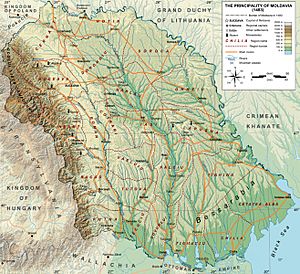
Stephen was the son of Bogdan, who was a son of Alexander the Good, a former Prince of Moldavia. Stephen's mother was Maria Oltea. Historians believe Stephen was born between 1433 and 1440. He had several brothers and sisters. His sister Maria married Șendrea, a high-ranking official. These family ties helped Stephen connect with important Moldavian noble families.
After Alexander the Good died in 1432, there was a long period of fighting over who would rule Moldavia. Stephen's father, Bogdan, became ruler in 1449. Stephen was named his father's heir and co-ruler. In 1451, Stephen's uncle, Peter III Aaron, killed Bogdan and took the throne. Stephen then fled to Hungary.
Vlad Țepeș, who had lived in Moldavia for a time, became the ruler of Wallachia in 1456. Stephen joined Vlad and, with his help, returned to Moldavia in 1457 with an army of 6,000 soldiers. People from southern Moldavia also joined him. Stephen defeated Peter Aaron twice, forcing him to leave Moldavia for Poland. Stephen was then officially made prince by Teoctist I, the Metropolitan of Moldavia. To show his rule was blessed by God, Stephen called himself "By the Grace of God, ... Stephen voivode, lord of the Moldavian lands."
Reign
First Years as Prince
One of Stephen's first actions was to attack Poland in 1458. He wanted to stop Poland from supporting Peter Aaron. Stephen aimed to get back Chilia, a port that had been given to Hungary in 1448. He signed a peace treaty with Poland in 1459. In this treaty, Stephen promised to support Poland against Tatar invaders. Poland, in return, promised to protect Stephen and keep Peter Aaron out of Moldavia.
Stephen attacked Transylvania, a region in Hungary, several times in 1461. The Hungarian King, Matthias Corvinus, then decided to support Peter Aaron. In 1462, Stephen showed he wanted good relations with the Ottoman Empire. He continued to pay the yearly tribute to the Ottoman Sultan, which his predecessor had started. He also made a new agreement with Poland in 1462.
In early 1462, Stephen's relationship with Vlad Țepeș became difficult. Stephen attacked Wallachia while Vlad Țepeș was fighting the Ottomans. The Ottoman Sultan, Mehmed II, invaded Wallachia in June 1462. Stephen's troops helped the Ottomans. Stephen also tried to capture Chilia in June, but he was seriously wounded during the siege.
Strengthening Moldavia
Stephen attacked Chilia again on January 24, 1465. His army bombarded the fortress for two days, and the defenders surrendered. Capturing Chilia caused problems with Hungary, Wallachia, and the Ottoman Empire. Around the same time, Stephen peacefully got back the fortress of Hotin (now Khotyn in Ukraine) from the Poles. To celebrate capturing Chilia, Stephen ordered the building of the Church of the Assumption of the Mother of God in 1466. This church became the main part of Putna Monastery.
In 1467, the leaders of Transylvania rebelled against King Matthias Corvinus of Hungary. Stephen promised to help them, but they gave up quickly. Corvinus then invaded Moldavia and captured several towns. Stephen gathered his army and defeated the Hungarians in the Battle of Baia on December 15. Corvinus was wounded and barely escaped. After this, some Moldavian nobles rebelled against Stephen, but he had them captured and executed.
Stephen swore loyalty to the Polish King Casimir IV again in 1468. He also raided Transylvania between 1468 and 1471. In 1470, Tatars invaded Moldavia, but Stephen defeated them in the Battle of Lipnic. To make his country stronger, Stephen built new fortresses at Old Orhei and Soroca. A Wallachian army tried to capture Chilia but failed.
Stephen invaded Wallachia in February 1470 and destroyed two important trading centers. In December 1470, Peter Aaron attacked Moldavia with Hungarian help, but Stephen defeated him and had him executed. Stephen also defeated Radu the Fair, the ruler of Wallachia, in 1471.
Wars with the Ottoman Empire
In the early 1470s, the Ottomans wanted Stephen to give up Chilia and Cetatea Albă. Instead, Stephen stopped paying his yearly tribute to the Ottoman Sultan in 1473. He also made friends with Uzun Hasan, a sultan who was fighting the Ottomans. Stephen invaded Wallachia to replace Radu the Fair, who was an Ottoman ally, with his own chosen ruler, Basarab III Laiotă. Stephen defeated the Wallachian army in November 1473 and placed Basarab on the throne. However, Radu quickly got Wallachia back with Ottoman help.
In late 1475, a huge Ottoman army of about 120,000 soldiers invaded Moldavia. Stephen also received help from Poland and Hungary. Stephen's army was much smaller, but he defeated the Ottomans in the Battle of Vaslui on January 10, 1475. This was one of the biggest European victories against the Ottomans. Stephen sent letters to European leaders, asking for their support and calling Moldavia "the Gateway of Christianity." Pope Sixtus IV praised him as "The true defender of the Christian faith." However, no one sent much help.
In the summer of 1476, Sultan Mehmed II himself led a new invasion against Moldavia. Stephen used a "scorched earth" tactic, burning crops and villages to deny the enemy supplies. He was defeated in the Battle of Valea Albă on July 26 and had to hide in Poland. However, the Ottomans could not capture Stephen's fortresses, like Suceava and Neamț. A lack of food and an outbreak of disease forced Mehmed to leave Moldavia. Stephen then returned from Poland.
Stephen and Vlad Țepeș invaded Wallachia in November 1476, forcing Basarab Laiotă to flee. However, Vlad Țepeș was killed soon after. Stephen then put another ruler, Basarab IV the Younger, on the Wallachian throne. Stephen kept trying to get Christian powers to fight the Ottomans. In 1480, he promised to start paying tribute to the Ottomans again. He also invaded Wallachia again, but the Ottomans still had a strong influence there.
Later Conflicts
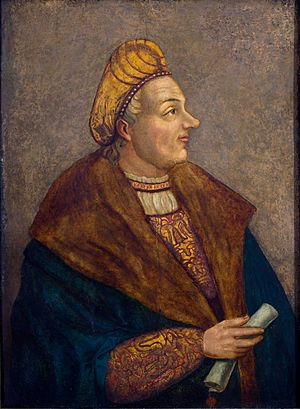
Sultan Mehmed II died in 1481. This allowed Stephen to attack Wallachia and the Ottoman Empire. He defeated Basarab the Younger and put Vlad Călugărul on the throne. But Vlad Călugărul soon had to accept the Sultan's rule. Stephen then made an alliance with Ivan III of Russia, the Grand Prince of Moscow.
In 1484, the new Ottoman Sultan, Bayezid II, invaded Moldavia. He captured Chilia and Cetatea Albă. These two ports gave the Ottomans control of the Black Sea. Stephen had to personally pay homage to Bayezid. Losing these ports meant Moldavia lost control of important trade routes.
King Casimir IV of Poland wanted to strengthen his power over Moldavia. He gathered an army of 20,000 soldiers. Stephen went to meet him and swore loyalty to Casimir in 1485. Casimir promised not to recognize the Ottoman capture of Chilia and Cetatea Albă without Stephen's agreement. While Stephen was in Poland, the Ottomans attacked Moldavia and looted Suceava.
Stephen returned and defeated the invaders with Polish help. He fought the Ottomans again in 1486 but could not get back Chilia and Cetatea Albă. He then signed a three-year peace agreement with the Ottomans, promising to pay yearly tribute.
Poland made a peace treaty with the Ottoman Empire in 1489, accepting the loss of Chilia and Cetatea Albă without Stephen's agreement. Stephen saw this as a betrayal. He then accepted the rule of Matthias Corvinus of Hungary. But Corvinus died in 1490. Stephen supported Vladislaus for the Hungarian throne to prevent Poland and Hungary from uniting under one king. Stephen also took back Pocuția (now Pokuttya in Ukraine), a territory he believed belonged to Moldavia.
In 1497, the new Polish King, John I Albert, attacked Moldavia. He wanted to make his younger brother, Sigismund, the ruler of Moldavia. Stephen, with help from Hungarian and Ottoman allies, defeated the Polish army in the Battle of the Cosmin Forest. Stephen tried again to recapture Chilia and Cetatea Albă but failed. In 1503, he had to accept that these two ports now belonged to the Ottomans.
During his last years, Stephen's son and co-ruler, Bogdan III, took on more responsibilities. Stephen's long rule brought a time of peace and strength to Moldavia.
Family
Stephen had several children. His first recognized son, Alexandru, was likely born to a woman named Mărușca. This Alexandru died in 1496.
Stephen married Evdochia of Kiev in 1463. She was related to important rulers in Moscow and Poland. Stephen and Evdochia had two children: Alexandru and Olena. Olena married Ivan Molodoy, the eldest son of Ivan III of Moscow.
Stephen's second wife was Maria of Mangup. She was from a royal family in Crimea. They married in 1472, but she died in 1477. Maria supported good relations between Stephen and Catholic countries.
Stephen's third wife was Maria Voichița, the daughter of Radu the Fair, the ruler of Wallachia. She was the mother of Stephen's next ruler, Bogdan, and a daughter named Maria. Stephen also had two other sons who died young: Bogdan (died 1479) and Peter (died 1480).
Stephen also had sons born outside of marriage. One was Mircea, born in the 1450s. Another was Petru Rareș, who later became Prince of Moldavia in 1527.
Legacy
Cultural Development
The years after Stephen's wars were a time of great cultural growth and building. More than a dozen stone churches were built because of Stephen. Rich nobles also built churches, and Stephen supported monasteries. For example, Voroneț Monastery was built in 1488, and Tazlău Monastery in 1496.
The new churches showed that Moldavia had its own style of architecture. They mixed parts of Byzantine and Gothic styles with local traditions. Churches built by Stephen often had painted walls and towers with a star-shaped base. Stephen also helped build churches in Transylvania and Wallachia, spreading Moldavian architecture. He ordered paintings and carved tombstones for his family. His own tomb at Putna Monastery was decorated with special leaves, which became a popular design in Moldavian art.
Stephen also helped develop history writing and literature in Moldavia. He ordered the collection of Moldavia's historical records. He also started the writing of at least three Slavonic chronicles. These chronicles were important for telling stories in a new way. The Chronicle of Bistrița told the history of Moldavia from 1359 to 1506. The two versions of the Chronicle of Putna covered the period from 1359 to 1526. Many religious texts were also copied and decorated with beautiful pictures, like portraits of Stephen.
National Hero
Stephen was called "Great" soon after he died. People remembered him as a strong leader. Even in the 16th century, people in Wallachia and Moldavia sang songs honoring him. He was also known as "Stephen the Old." Local stories said Stephen protected peasants from nobles and foreign invaders. Peasants often claimed their land was given to their ancestors by Stephen for their bravery in battle.
Stephen became a very important figure in Romanian nationalism, which aimed to unite Moldavia and Wallachia. Writers and artists created works about him. In the 1840s, Alecu Russo started collecting folk stories about Stephen. The poem "The Aprod Purice" by Constantin Negruzzi tells a fictional story about the battle of Șcheia. In Bessarabia, which was part of the Russian Empire, people saw Stephen as a symbol of resistance.
Nicolae Bălcescu was the first Romanian historian to call Stephen a national hero. He believed Stephen's rule was a step towards uniting all Romanian lands. Stephen was mentioned in the Romanian national anthem. In 1883, a statue of Stephen was put up in Iași.
On the 400th anniversary of his death in 1904, many ceremonies were held. Nicolae Iorga published Stephen's biography. He said Stephen's victories were because "the whole people" united during his rule. Many more books and poems about Stephen appeared, making his cultural importance even stronger.
During the Communist era in Romania, Stephen's image changed. At first, they didn't like his treatment of peasants. But later, he was shown as a symbol of national identity and independence. Today, Stephen is a constant symbol in both Romania and Moldova. Statues of him are everywhere. Politicians mention him, and schools and universities are named after him. His face is on every banknote in Moldova. In a 1999 poll, over 13% of Romanians said Stephen the Great was the most important person who improved their country. In 2006, he was voted "the greatest Romanian of all time."
Holy Ruler
| Saint Stephen the Great | |
|---|---|

Votive depiction of Stephen at Dobrovăț Monastery
|
|
| Holy Voivode | |
| Venerated in | Romanian Orthodox Church |
| Canonized | 12 July 1992, Bucharest, Romania by Romanian Orthodox Church |
| Major shrine | Putna Monastery |
| Feast | 2 July |
In old stories and chronicles, Stephen's victories were seen as inspired by God or by saints. People started to worship Stephen himself in the 1570s. According to Grigore Ureche, people thought he was a saint soon after he died. This was because of his "great deeds," even though he was "a man with sins."
In 1851, the abbot of Putna Monastery started looking into Stephen's tomb. In 1857, a priest wrote about the "holy bones of Putna." Some legends say Stephen is a "sleeping hero" who will return, or even that he rules heaven.
The Romanian Orthodox Church made Stephen a saint on June 21, 1992. The Patriarch of Romania said Stephen was a defender of Christianity and his people. He also pointed out that Stephen built many churches. Stephen's feast day is July 2nd, the day he died. On his first feast day after becoming a saint, 15,000 people gathered at Putna Monastery to celebrate.
Arms
Stephen's rule made the coat of arms of Moldavia more common. This coat of arms showed the head of an aurochs (a type of wild ox). It also sometimes had a rose, a crescent moon, a sun, and a star. The colors of this coat of arms are not fully known.
Stephen also used his own personal coat of arms. It had a shield divided into four parts, with one part striped. The colors of this shield are also uncertain. These symbols might have come from Hungarian coats of arms or from Moldavian traditions. He also used symbols like the fleur-de-lis and the Cross of Lorraine.
Stephen's symbols slowly blended with those of the House of Bogdan-Mușat, his family. All princes who claimed to be related to Alexander the Good used these symbols. The tombstones of Stephen's two sons who died young, Bogdan and Peter, show the aurochs symbol.
An old Moldavian flag from the Battle of Baia also exists in drawings. It shows an aurochs head and stripes. Another famous "war flag" is red with an image of Saint George and the Dragon. Stephen supposedly gave this flag to a monastery. However, some historians believe this flag was too small for battle and was more likely a religious gift.
See also
 In Spanish: Esteban III de Moldavia para niños
In Spanish: Esteban III de Moldavia para niños


